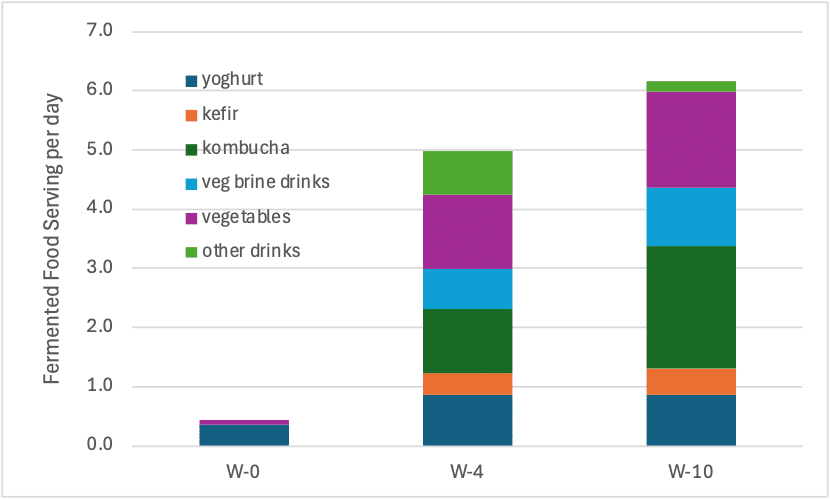Take home message
- There is growing interest in the health benefits of consuming live bacteria (and fungi).
- Studies show a difference in many aspects of our health, including mortality, as the amount of fermented products consumed per day increases.
- Experimental research, in which volunteers consumed an average of more than six portions of fermented products, shows that the diversity of the gut microbiome increases and inflammation levels in the blood and gut decrease.
- These are ‘ordinary fermented products’ (quark, yoghurt, kefir, kimchi and vegetable juices), not specific probiotic products.
Interest in live bacteria
Is the die cast? If you believe the title of an article in the journal Trends in Food Science, it certainly seems so: ‘The future is fermented: Microbial diversity is an important source for food improvement and human health’ (Hernandez-Velazquez et al., 2024). The food industry has made us dependent on foods that are mainly killed, packaged, processed, refined, improved and composite. This is despite the fact that less than 100 years ago, we mainly prepared our own food, processed it at home and fermented it so that we would have food available in winter. Cabbage became sauerkraut, milk became yoghurt and cheese, and grain became sourdough bread or beer, grapes became wine. In addition to fermentation, people used air drying or drying in the chimney (fish became stockfish, meat became smoked sausage/meat) and salting or brining.
Fermentation, probiotics and postbiotics
During fermentation by bacteria, fungi and yeasts, milk sugar is converted into lactic acid and alcohol. Certain strains of bacteria can be probiotic, meaning that ‘they have been proven to have a beneficial effect on health and can also reach the intestinal tract of humans and animals’. Not every bacterial strain is probiotic, and non-probiotic strains are also referred to as commensal microorganisms in food. On the other hand, not every fermented product contains live bacteria. After fermentation, a product can also be heated or further processed, killing the bacteria. However, bacteria can leave traces in the form of conversion products, such as bioactive peptides or lactic acid. This is called the postbiotic effect, an impact after death.
Chinese researchers have analysed the open database that exists in the United States under the name NHANES study (National Health and Nutrition Examination Survey). This database contains long-term data on the lives of many Americans. In various publications (in 2024 and 2025), the researchers calculated the correlations between the estimated intake of live microorganisms and numerous health aspects: chronic constipation, ageing, mortality from cardiovascular disease or overall mortality (Zhu et al., 2024; Zheng et al., 2025), depressive symptoms, suicide, obesity, metabolic syndrome, kidney stones, osteoporosis, periodontitis, COPD or calcification of the aorta. The studies mostly focus on the general intake of live bacteria. Due to the expected variation in the number of live microorganisms in each type of food, the foods were classified into categories with a range defined as low (Low; <104 CFU/g), medium (Medium; 104-107 CFU/g) or high (High; >107CFU/g) levels of live microbes. These levels of Low, Medium and High were chosen to reflect the numbers of viable microbes expected to be present in pasteurised foods (<104CFU/g); fresh fruit and unpeeled vegetables (104-107 CFU/g), and unpasteurised fermented foods (most dairy products) and probiotic supplements (>107 CFU/g). This involves the coding of nearly 9,400 food items in the US (Marco et al., 2022). Incidentally, the majority of foods (almost 9,000 items) fall into the <104 CFU/g category. This indicates that most foods consist of processed, composite and heated components. Of adults over the age of 19, just under 5% of their daily diet in kcal comes from the medium and high groups. Yoghurt consumption made a significant contribution to this.
Nutritional experiment with live bacteria
An experimental study (Wastyk et al., 2021) was conducted to investigate the difference between a fibre-rich diet and a diet rich in live microorganisms on clinical changes, blood parameters and health in adults. One group increased the proportion of plant fibres in their daily diet, while the other increased the proportion of fermented products. The number of publications referring to this study is extremely high (as of 7 June 2025: 1065 publications), which indicates how important this study is considered to be and how original this experiment is.
The American study was conducted mainly among white (81%) women (73%) with a BMI of 25 and an age of 52. For 10 weeks, they were given either a fibre-rich, ‘prebiotic’ diet or a fermented diet based mainly on drinks containing large amounts of live bacteria. At the start, the gut microbiome was the same in both groups. The most significant difference arose in the group that consumed the fermented drinks and foods. In this group, the number of servings of fermented products rose from 0.4 (before the study) to more than 6 servings per day. At the start, the fermented products consisted mainly of yoghurt. This was followed by a wide range of fermented drinks and foods. Kombucha and fermented vegetables, as well as fermented vegetable juices, appeared alongside an increase in yoghurt and the introduction of kefir (Figure 1).

Fig. 1. Average of the different fermented foods (n=18 participants), at the start (week 0) and after 4 and 10 weeks (derived from Wastyk et al., 2021).
By the way, our own measurements of the raw milk kefir from the Raw Milk Company give the following values: ‘Kefir based on the Hansen culture contains 90 million bacteria per ml of product, and original kefir based on kefir grains (SCOBY) contains almost 2 billion bacteria. The number of yeasts per ml of product is approximately 7,000 in Hansen kefir and 10 times as many in oerkefir. The majority of the bacteria consist of lactic acid bacteria.” A product such as raw milk kefir therefore makes an enormous contribution to the daily intake of live bacteria.
Only in the fermentation group, not in the fibre group, there was (1) a constant increase in the biodiversity of the gut microbiome, which was stronger the more portions were consumed per day; (2) a decrease in inflammation markers in the blood and gut (antibodies, cytokines); (3) initially, a slightly more bloated feeling, which disappeared later; (4) changes in the intestinal wall (intestinal villi). It is also interesting to note that despite the fermented diet, (5) the composition of the gut microbiome remained highly individual, in other words, the existing gut flora was influenced, but the bacteria and fungi from the fermented products were unable to displace the individual’s own gut flora. The increase in diversity was mainly within the Firmicutes phylum, and within that phylum by the Lachnospiraceae (4x), Ruminococcaceae (2x) and Streptococcaceae (1x) families. Of the new species, only a small proportion (5%) could be directly traced back to the composition of the fermented products. This means that (6) the increase in new species originates from bacteria that are latently present in the intestine and are given the opportunity to grow by the fermented products, or from other sources. One of the negative effects of our current Western lifestyle is the constant low grade of inflammation that we carry with us. The cytokines like IL6 show that there is constant inflammation. During the course of the experiment (10 weeks), the inflammation values in the blood decreased gradually but continuously. This means that the body is better able to cope with chronic inflammation, and non-communicable diseases caused by diet and lifestyle, such as rheumatoid arthritis, type 2 diabetes or chronic stress, will decrease.
Weston A. Price discovered this back in the 1930s
Traditional living peoples were characterised by their interest in raw and raw fermented products. They too knew this, without any scientific knowledge. It was life experience and survival experience. It was not so much vegetarianism that was important for their health, but fermentation. In the Swiss Lötschendal, this was sourdough rye bread, together with raw milk (goat and cow), raw milk butter and mountain cheese made from raw milk.
Hippocrates’ statement, which we have included at the bottom of the website, says: “Let food be thy medicine, and medicine be thy food. … All disease begins in the gut.” Research into the intake of live bacteria confirms his insight and was conducted long before we knew anything about the micro-life of food.
Conclusions
The daily intake of live bacteria through the consumption of fermented foods increases the diversity of the intestinal flora and reduces inflammation in the blood and intestines without actually replacing the intestinal microbiome with the microbiome of the fermented food. It seems more likely that fermented foods promote the diversity of the intestinal flora.
Literature
- Hernández-Velázquez, R., Flörl, L., Lavrinienko, A., Sebechlebská, Z., Merk, L., Greppi, A., & Bokulich, N. A. (2024). The future is fermented: Microbial biodiversity of fermented foods is a critical resource for food innovation and human health. Trends in Food Science & Technology, 104569.
- Marco, M. L., Hutkins, R., Hill, C., Fulgoni III, V. L., Cifelli, C. J., Gahche, J., … & Sanders, M. E. (2022). A classification system for defining and estimating dietary intake of live microbes in US adults and children. The Journal of nutrition, 152(7), 1729-1736.
- Wastyk, H. C., Fragiadakis, G. K., Perelman, D., Dahan, D., Merrill, B. D., Yu, F. B., … & Sonnenburg, J. L. (2021). Gut-microbiota-targeted diets modulate human immune status. Cell, 184(16), 4137-4153. DOI: 10.1016/j.cell.2021.06.019
- Zheng, S., Lou, Y., Zhang, J., Wang, Y., & Lv, L. (2025). Association of dietary live microbe intake with all-cause and cardiovascular mortality in an older population: Evidence from NHANES 2003-2018. Archives of Gerontology and Geriatrics, 131, 105741.
- Zhu, X., Chen, W., Xue, J., Dai, W., Maimaitituerxun, R., Liu, Y., … & Xie, H. (2024). Dietary live microbes intake associated with biological aging and mortality. The Journals of Gerontology, Series A: Biological Sciences and Medical Sciences, 79(11), glae202.




